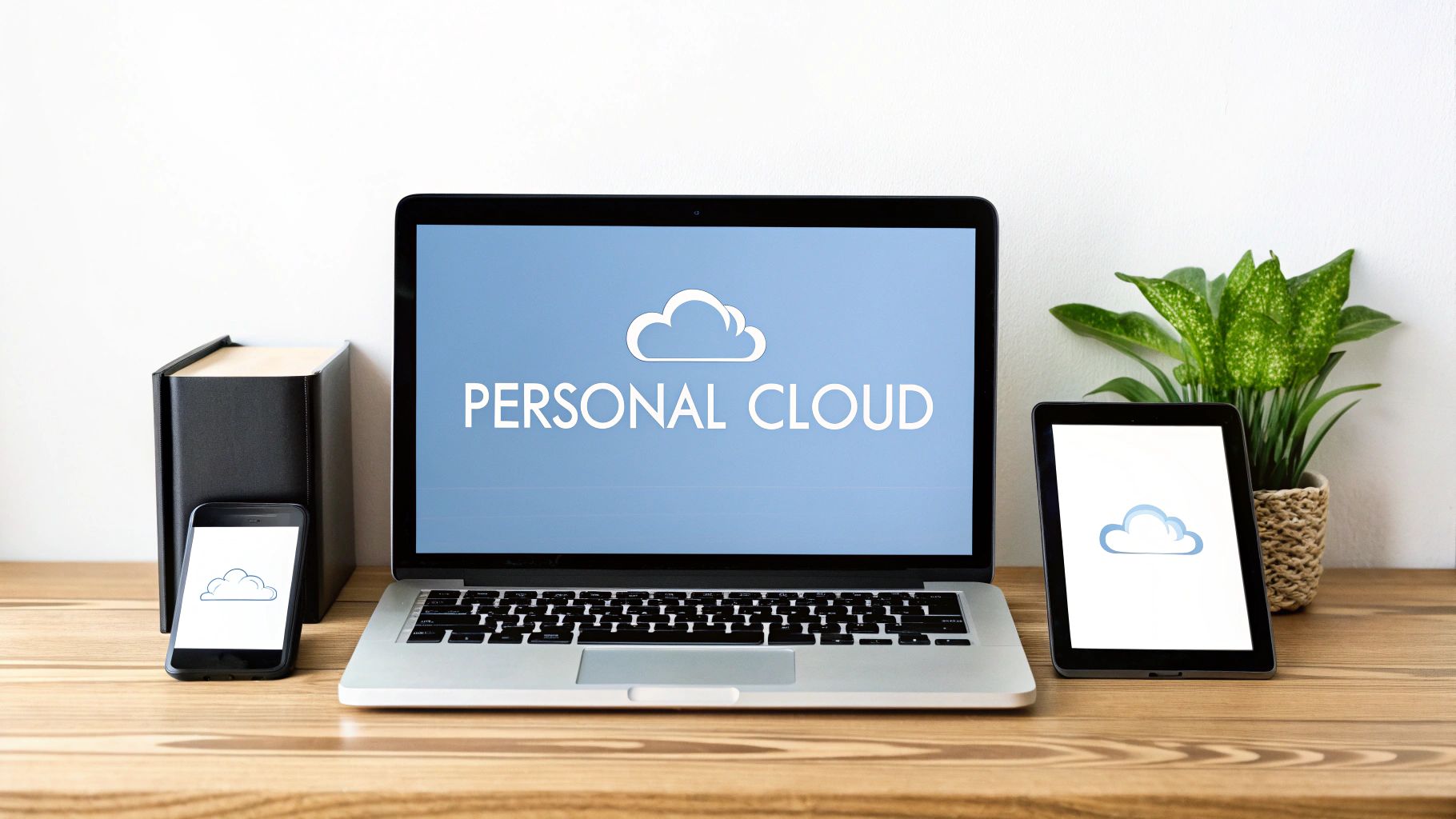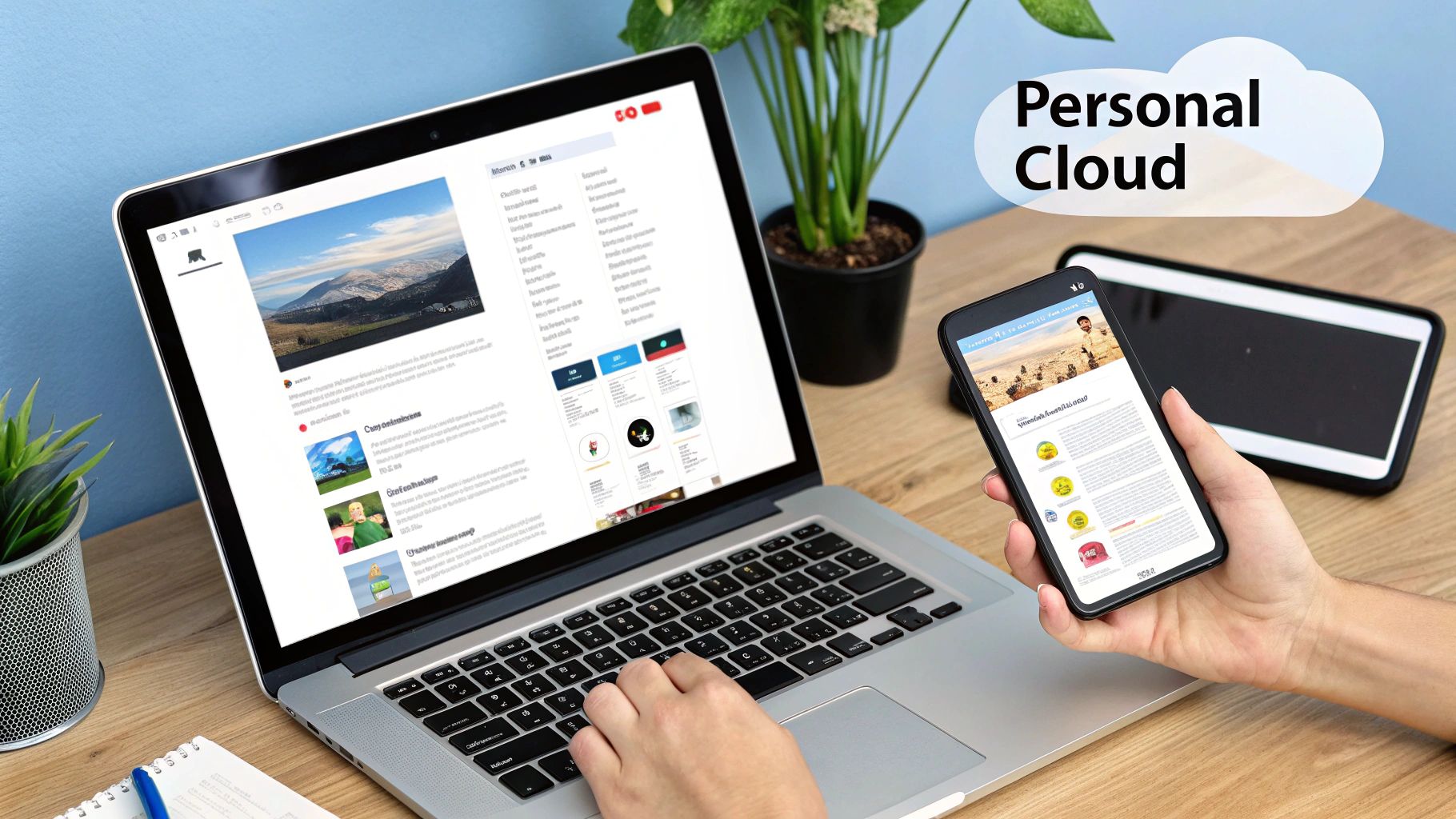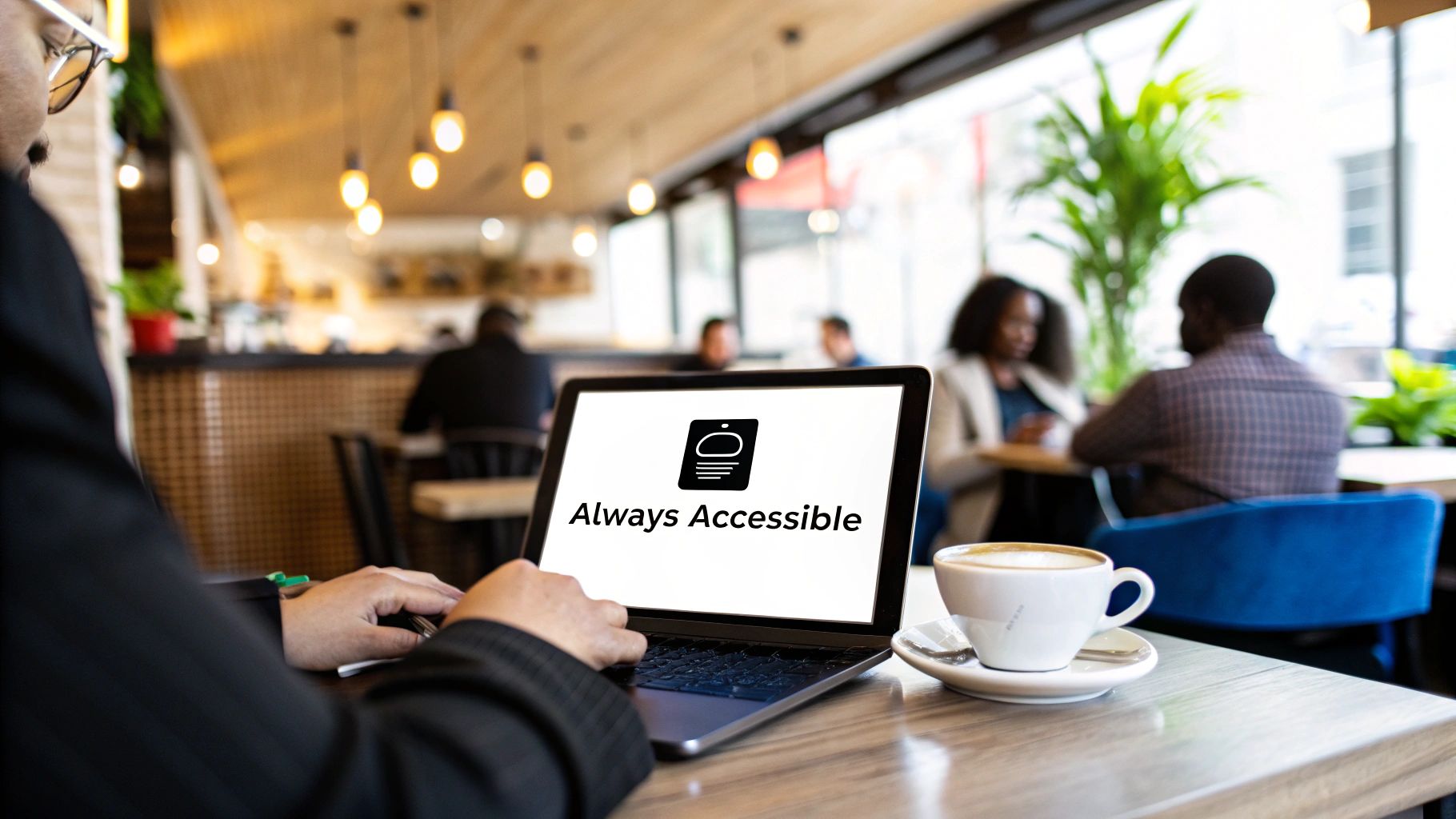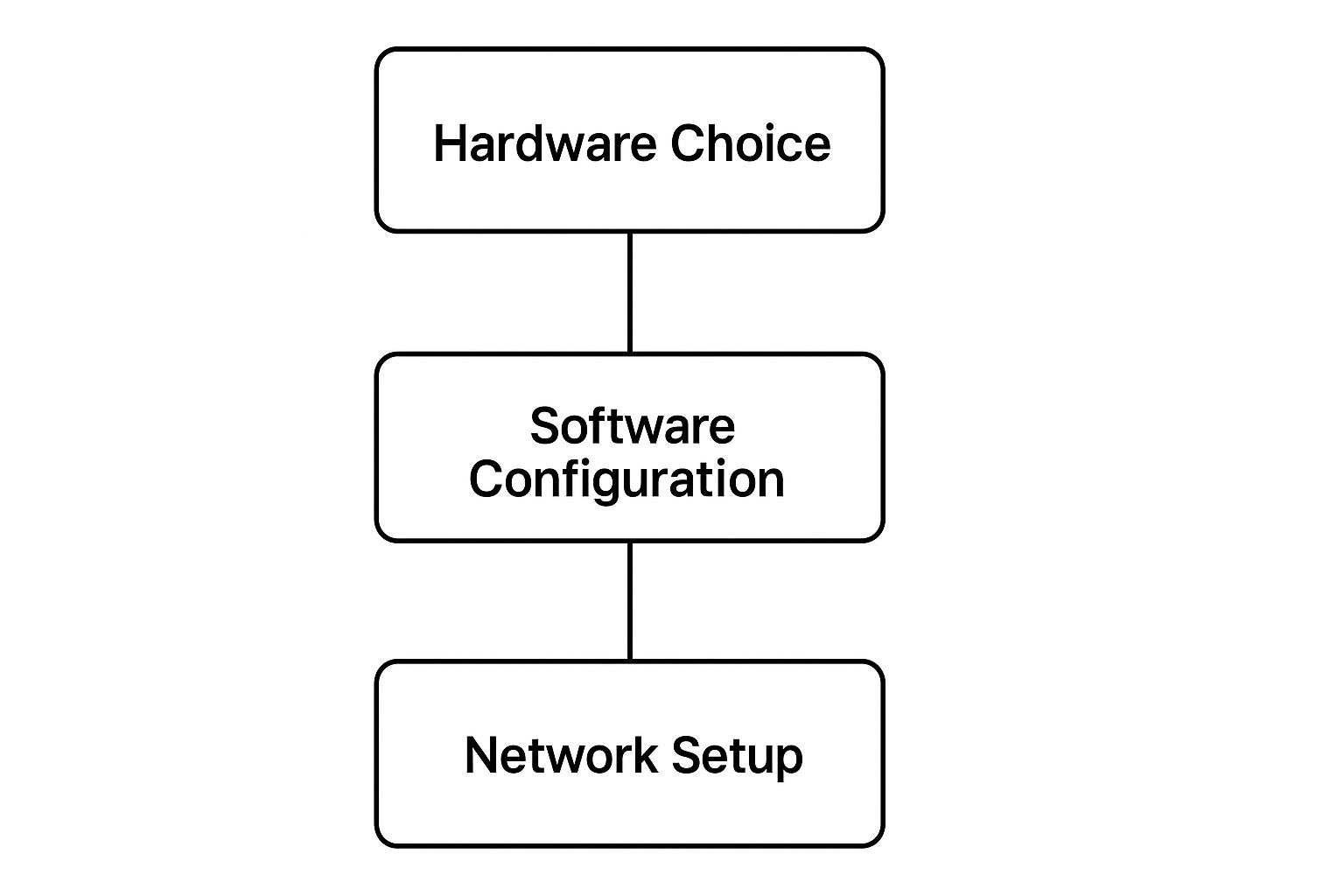Address
Australia, Singapore, and USA
Address
Australia, Singapore, and USA

Explore what personal cloud storage is and how to choose the right service. This guide covers benefits, features, security, and key differences.
Ever felt like your digital life is scattered across a half-dozen different devices? Photos on your phone, work documents on your laptop, and that one important file… well, who knows where that ended up. This is the exact problem personal cloud storage was built to solve.
Think of it less like a dusty filing cabinet and more like your own personal, infinitely expandable hard drive that lives in the sky. It's an online service that lets you save files, photos, and documents to a central, secure hub, making them instantly available wherever you have an internet connection.

Personal cloud storage breaks down the invisible walls that separate our devices. In the past, a photo taken on your phone was stuck on your phone. A presentation built on your work computer stayed on that computer. This created frustrating "digital silos," making it a constant chore to find and manage your own information.
This modern approach completely changes how we interact with our files. Instead of saving something to a specific device, you save it to your cloud account. The service then works its magic, automatically synchronizing that file across all your connected devices—your phone, laptop, tablet, and desktop.
Let's follow a single photo to see how this works in the real world.
This seamless flow makes your files "device-agnostic." The file no longer lives on a physical hard drive; it lives in your central hub, ready for you whenever and wherever you need it.
A common myth is that cloud storage is just for backups. While it’s fantastic for protecting your data, its main job is active file management—making your files universally accessible and synced for everyday use.
Picture a family on vacation. The parents are taking photos on their phones, while the kids are shooting videos on a tablet. With a shared personal cloud storage folder, every new photo and video instantly gets added to a central collection that everyone can see.
Back at the hotel, they can pull up a combined album of the day's memories on a laptop without anyone having to text or email a single file. This ability to turn scattered digital moments into a cohesive, shared experience is a huge reason for its popularity.
The global use of personal cloud storage has exploded, showing just how much people want a better way to manage their digital lives. Back in 2014, there were about 1.1 billion users. By 2025, that number had more than doubled to an estimated 2.3 billion users worldwide. This incredible growth is fueled by our reliance on smartphones and the need to access our files from anywhere. You can dive deeper into this trend and its impact on global data habits on threadgoldconsulting.com.

Shifting your digital life to a personal cloud storage solution does so much more than just give you a place to park files. It completely overhauls how you manage, safeguard, and share the information that matters most. The benefits go way beyond simple convenience, offering a mix of access, security, and smart features that solve a ton of common digital headaches.
Let's dive into the core advantages that make personal cloud storage practically a must-have tool today. I'll break them down with real-world examples that show exactly how they make life easier.
The most immediate "aha!" moment with cloud storage is the freedom it gives you. Your files are no longer stuck on a single laptop or phone. Instead, they live in one central, secure spot you can get to from any device with an internet connection.
Picture this: you're on your way to a big client meeting and suddenly realize you need to fix a typo in your presentation. Instead of a full-blown panic, you just pull out your phone, open your cloud app, and make the quick edit. By the time you arrive and open your laptop, the corrected version is right there, ready to go. What could have been a disaster is now just a minor hiccup.
Losing a laptop or having your phone stolen is awful. The thought of losing all your irreplaceable photos, documents, and memories on top of that is even worse. Personal cloud storage acts as your digital safety net against device failure, loss, or theft.
Most services come with automatic backup and sync features. Every time you create or change a file, a copy is instantly whisked away to the cloud. If your computer's hard drive ever gives up the ghost or your phone goes missing, all your data is safe and sound. You just log into your account on a new device, and everything is restored. It's hands-off protection that delivers some serious peace of mind.
A study by the Aberdeen Group found that businesses using cloud solutions resolved disaster recovery issues in just 2.1 hours on average, compared to 8 hours for those without. The same speedy recovery principle applies to your personal data.
Remember the bad old days of emailing different versions of a document back and forth? The confusing reply chains, the "final_v2_final_final" file names… it was a mess. Cloud storage makes working together simple and, frankly, a lot less frustrating.
Imagine a group of students tackling a project. They can all work on the same document in a shared folder, at the same time.
This isn't just for school projects. Families can plan vacations with a shared spreadsheet, or freelancers can show clients design mockups in a shared folder. This streamlined approach is also crucial for a secure online file transfer, because you can manage who sees what without attaching sensitive files to emails.
High-resolution photos, 4K videos, and big apps can chew through the storage on your phone, tablet, or laptop in no time. Personal cloud storage offers a brilliant fix for this all-too-common problem by letting you offload bulky files without losing access to them.
Many cloud apps have a "free up space" button that removes the full-sized file from your device, leaving behind a small thumbnail. You can still scroll through your entire photo library on your phone, but the files themselves aren't hogging your storage. When you need the high-quality version, just tap to download it. It’s the best of both worlds.
When you start shopping for personal cloud storage, it's easy to get tunnel-vision on just two things: how much space you get and how much it costs. While those numbers matter, they don't tell you the whole story. The real value of a service is in its features—the thoughtful little details that make managing and protecting your digital life feel effortless.
It’s a lot like buying a car. You wouldn't just look at the trunk size and the price tag. You’d want to know about its safety features, how it handles on the road, and if it has the modern tech you need. The same logic applies here. The best services are about more than just raw storage; they're built on a foundation of smart, user-friendly features.
The real magic of personal cloud is sync. It’s the feature that makes a file you just saved on your laptop instantly appear on your phone, ready to go. Great sync works quietly in the background, so you never even have to think about it.
Keep an eye out for a "selective sync" option. This is a game-changer. It lets you decide exactly which folders sync to which devices. For example, you can sync your entire photo library to your big desktop PC but only sync a "Current Projects" folder to your laptop to save precious hard drive space. That level of control is crucial for keeping your storage organized and efficient across all your gadgets.
In an era of endless digital threats, security isn't just a feature—it's a requirement. Your personal cloud will hold your most important files, from sensitive documents to irreplaceable family photos, so its defenses have to be rock-solid. A good provider won't just say they're secure; they'll be completely open about how they protect you.
Here are the security features you should absolutely demand:
End-to-end encryption means you are the only one who can ever see your content. It basically turns the provider's servers into a secure, unreadable vault that only you hold the key to. For true privacy, it's non-negotiable.
Of course, once your files are secure, you need to know how to share them without creating new risks. For more on that, check out our guide on how to use encrypted file sharing to keep things locked down when you collaborate.
This infographic breaks down the different layers that create a truly secure personal cloud, from the physical hardware up to your network settings.

As you can see, a genuinely secure system isn't about one single thing. It's about making smart choices at the hardware, software, and network levels to build a layered defense for your data.
Have you ever accidentally saved over an important document or deleted a paragraph you spent hours perfecting? That's where file versioning, or version history, comes to the rescue. It’s like a time machine for your files, automatically saving a snapshot every time you make a change.
If you mess something up, you can just roll back to an earlier version of the file in seconds. This feature is an absolute lifesaver for anyone working on creative projects, important reports, or anything collaborative. It's the safety net that protects you from a simple mistake or even file corruption.
One of the best parts of cloud storage is how easy it makes sharing files. But that convenience should never force you to give up control. A top-tier service will give you precise power over who can see your files and what they can do with them.
Here are the sharing options to look for:
These kinds of controls ensure you're always in command of your data, even long after you've hit the "share" button.

When you start looking for personal cloud storage, you'll quickly run into two main paths: the public cloud and the private cloud. Figuring out the difference is key, because it impacts everything from what you'll pay to how much control you truly have over your files.
I like to think of it like finding a place to live. A public cloud is like renting a slick, modern apartment in a high-security complex. It’s incredibly convenient. The management handles all the maintenance, security, and utilities for you. All you have to do is move in.
A private cloud, on the other hand, is like owning your own house. You have total control over every single detail, from the locks on the doors to the color of the paint. But that freedom comes with responsibility—you’re the one fixing the leaky roof and mowing the lawn.
Both options give you a place to keep your digital life, but the experience, cost, and control are fundamentally different.
Public cloud services are what most of us picture when we hear "cloud storage." These are the big-name services where you pay a company to store your data on their massive, professionally managed servers.
The whole model is built around simplicity and getting you started fast. You sign up, install an app, and you can be uploading files in minutes. The provider takes care of all the messy background work—server maintenance, security patches, hardware failures—so you never have to think about it. You get the benefits of powerful infrastructure without any of the headaches.
Of course, that convenience comes with a trade-off. Your data is living on servers you don't own, managed by a third party. While the top providers have phenomenal security, at the end of the day, you're trusting their systems and policies to keep your information safe.
The public cloud is a shared space. While your data is kept separate and private, you're one of millions of tenants using the same underlying hardware. This multi-tenant approach is precisely what makes it so affordable and easy to scale.
For personal use, a private cloud usually means setting up a Network Attached Storage (NAS) device right in your home. A NAS is basically a small, smart server with its own hard drives that plugs into your home network. It creates a personal cloud that you own and control completely.
With a private cloud, your data never leaves your house unless you choose to access it from somewhere else. You are in the driver's seat for security, backups, and software updates. This gives you unmatched privacy and control, as no third party can ever access or scan your files.
This absolute control is a double-edged sword, though. You have to cover the initial hardware cost, which can be a significant investment. You also have to manage the device yourself, from setting it up correctly to making sure it’s secure from online threats and running regular backups. It definitely requires more technical know-how than just signing up for a service.
To make the right call, it helps to see how these two models stack up on the things that matter most.
Ease of Use
Control and Privacy
Cost Structure
Security
No matter which path you choose, understanding how to share your data safely is vital. You can learn more about best practices in our guide on how to achieve secure document sharing in any cloud setup. The best personal cloud storage for you ultimately comes down to balancing your need for convenience against your desire for control.
Choosing a personal cloud storage service can feel a lot like walking into a massive electronics store. You’re hit with a wall of options that all seem to do the same thing, but you know the devil is in the details. Getting bogged down in feature lists and marketing jargon is a surefire way to get overwhelmed.
The secret isn't to start with the services, but to start with yourself. The perfect cloud setup for a professional photographer is worlds apart from what a student or a busy family needs. A little self-reflection will quickly clear the fog and point you toward the right choice.
First thing's first: what problem are you actually trying to solve? Pinpointing your main goal is the fastest way to filter out all the noise and focus on what truly matters.
Simple Photo and Video Backup: Is your main goal just to get all those precious photos and videos off your phone and into a safe place? If so, you'll want to prioritize services with killer mobile apps, automatic camera uploads, and smart photo galleries.
Work and Productivity Hub: Are you looking for a central place to store, sync, and collaborate on documents and presentations? Your best bet is a service that plays nicely with office software and has rock-solid tools for working with a team.
Large File Archiving and Sharing: If you’re a creator, freelancer, or anyone juggling massive files like raw video or design projects, your search should start and end with storage capacity, file size limits, and powerful sharing options.
Nailing down your "why" makes the rest of the process much, much easier.
Next, take a quick inventory of the gadgets you use every day. The best cloud service is one that fades into the background, not one you have to constantly fight with.
Do you live exclusively in the Apple world with an iPhone, iPad, and Mac? Or are you a mix-and-match person with a Windows PC and an Android phone? Some services, like iCloud, are built to live inside one ecosystem. Others, like Dropbox or Google Drive, are designed to work seamlessly everywhere. Going with a platform-agnostic service is often a smart move for future-proofing.
The goal is to find a service that disappears into the background. It should sync your files flawlessly across all your gadgets without you ever having to think about it. If you have to fight with the software, it’s the wrong choice.
To really zero in on the perfect fit, run through this quick checklist. Your answers will create a clear profile of exactly what you need from a provider.
Taking the time to think through this is more important than ever. The global personal cloud storage market is exploding and is projected to hit USD 80.0 billion by 2032. That growth is fueled by the sheer amount of data we all create every day, making a smart choice from the start absolutely essential. You can dig into the details of this market growth on contentenginellc.com.
Even after you've gotten the hang of personal cloud storage, it’s completely normal to have some questions. We're talking about your most important files, after all, so a few "what if" scenarios are bound to cross your mind. Think of this as your go-to guide for clearing up those common uncertainties.
We've pulled together the questions we hear most often from people trying to choose the right cloud service. Our goal is to give you simple, direct answers without the tech-speak, so you can feel confident in your decision.
This is usually the first question people ask, and for good reason. The short answer is yes—reputable cloud storage is incredibly secure, often far more so than your home computer. These companies invest millions in physical and digital security measures that are simply out of reach for an individual.
Most services rely on powerful encryption protocols like AES-256 to shield your data. This protection works at two critical points:
For the ultimate peace of mind, look for services that offer zero-knowledge or end-to-end encryption (E2EE). This is the gold standard for privacy. It means your files are encrypted on your device before they even leave it, and only you hold the key to unlock them. Not even employees at the cloud company can see your content. And no matter what, always enable two-factor authentication (2FA) on your account—it’s an essential extra lock on your digital front door.
This is a really common point of confusion, mainly because the terms get thrown around interchangeably. But they serve very different purposes. Think of it this way: cloud storage is your active, daily-use digital workspace, while cloud backup is your emergency insurance policy.
Cloud Storage: This is for active file management. It’s where you store, access, sync, and share the files you work with all the time. It’s your go-to digital filing cabinet.
Cloud Backup: This is designed for disaster recovery. Its main job is to create a complete copy of your data that you can restore if your original files are ever lost, stolen, or corrupted. It's more of a "set it and forget it" safety net.
While many personal cloud storage services now offer backup-like features, their real strength is in making your files accessible and easy to sync. Dedicated backup services, on the other hand, are built purely for creating a secure archive you can restore from. Many people end up using both to create a truly comprehensive data protection strategy.
There’s no one-size-fits-all answer here; it all comes down to your digital lifestyle. The best place to start is by checking how much space you’re currently using on your computer and phone. That’ll give you a solid baseline.
Here’s a rough guide to help you estimate:
The great thing is that almost every personal cloud storage provider offers flexible plans. You can always start small and cheap, then easily upgrade as your digital world grows.
It's a valid concern, but with established providers, the risk is incredibly low. A reputable company won’t just disappear overnight. In the highly unlikely event of a shutdown, they are legally and ethically required to give you plenty of warning—usually several months—to download all your data and move it somewhere else.
The best way to protect yourself is to stick with well-known companies that have been around for a while. For your truly irreplaceable files, it’s smart to follow the 3-2-1 backup rule: keep three copies of your data, on two different types of media, with one of those copies stored off-site. Your personal cloud storage account is the perfect solution for that off-site copy.
One of the best real-world perks of personal cloud storage is finally breaking free from email attachment limits. Sharing a huge video file, a high-res photo album, or a massive project folder becomes incredibly simple.
Most services let you create a secure link to any file or folder. You can send this link to anyone, and they can view or download the files right from their browser—no account needed. For sensitive stuff, you can usually add a password or set the link to expire after a certain date for extra security. If you're a filmmaker or content creator, you can dig deeper into the best methods for how to share large video files without killing the quality.
Ready to centralize your digital life with a secure, flexible, and powerful solution? Sky Drive Folder offers up to 5TB of storage, robust AES-256 encryption, and advanced sharing controls to give you complete command over your files. Explore our plans today and discover a smarter way to store and share.
[…] personal cloud storage can offer secure and private file access, you can read this related article: Personal Cloud Storage for Secure, Private File Access Anywhere. This article delves into the benefits of using personal cloud storage and how it can enhance your […]